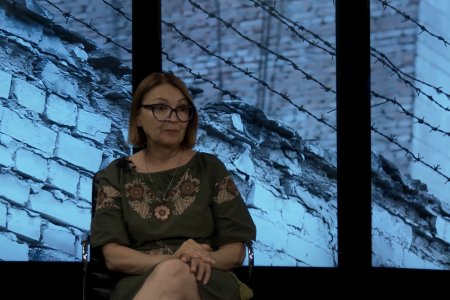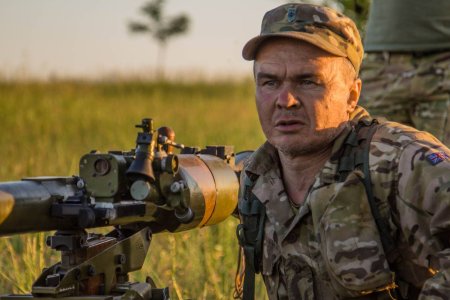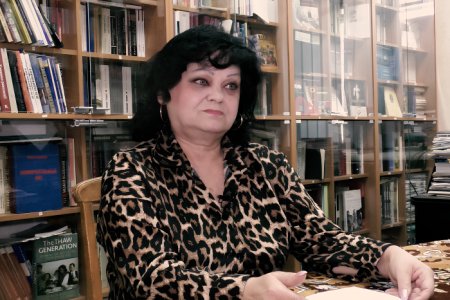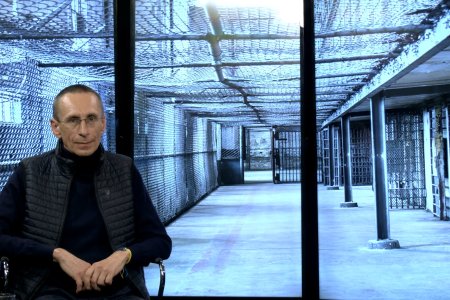My name is Maryna Tetiana Oleksandrivna. I am the common-law wife of Spanish citizen and Ukrainian volunteer Mariano Garcia Calatayud, who turned 76 on February 2, 2024. Unfortunately, he has been in Russian captivity for over two years.
What happened in Kherson at the beginning of the Russian occupation?
At the beginning of the occupation, when the food blockade of the city occurred and bank accounts were blocked, slight chaos began in the city. When Russian troops entered the city, they immediately occupied the Kherson Regional State Administration building and set up headquarters there. People began to come out to protest rallies.
On March 5, the largest protest rally took place. According to journalists who covered it at the national level, including the Freedom TV channel and others, about 10,000 people gathered for the rally. As an eyewitness, I can say that there were really, really many people. Of course, my husband, Mariano, and I went there.
The Russians immediately set up a reinforced cordon of their soldiers and filmed the rally from a helicopter. They were trying to identify opinion leaders, those who could incite the townspeople to resist.

It was not in their interests to immediately commit any atrocities in the regional center because they wanted to present Kherson as a showcase: look, we came here, freed the citizens, everyone here is for us. Everyone loves us.
We all remember that wonderful guy from the national police who jumped on a Russian armored personnel carrier with a Ukrainian flag at this rally. It was something incredible. There was such inspiration. We honestly thought the Russians would see how unwelcome they were in this city, turn around, and leave. It was a very naive idea.
When did they start using force against the protesters?
On March 21, the Russians decided, as they say, to stop this circus, and they shot the protesters. People, as usual, gathered at 10:00 in the morning, but everything happened in a slightly different scenario that day. The cordon that was set up around the regional state administration suddenly began to move towards us, and they pointed machine guns at us.
As a civilian, I have never heard a machine gun burst in real life, only in a movie. It is such a dull sound. I would never have thought in my life that they were shooting at us. It is like a car driving on gravel. These are not the special effects we are used to in the movies. It wasn’t even me who realized that they were shooting at us, but my friend. She quickly pulled me by the sleeve and said: “Run, they’re shooting at us!”

What did Mariano do before the war?
He left a comfortable life in Spain and came to Ukraine to volunteer (Mariаno has been volunteering since 2014, editor’s note). As far as I understand, this was not his first experience. He did something similar in Africa. He told me how he interacted with the Maasai tribe there. It is probably his adventurous nature. Not everyone can abandon a comfortable life, go to a country at war despite the embassy’s recommendations, and go to the front line to help civilians.
So, you understand, volunteer work is a certain amount of physical exertion. It was not like he just walked around and gave orders: send this cargo there, this one here. No. He loaded all the cargo and unloaded the minibusses with his hands. He collected humanitarian aid and things himself. He invested his own money. He retired early. He had social security of €1,600. For Spain, this is a good income; he could just live without knowing the need for anything.

When and how did Mariano disappear?
At 9:00 am on March 19, 2022, was the last day I saw him with my own eyes, talked to him, and heard his voice. At 1:51 pm, he came home. Mariano called me because he had not taken the keys. “Please come out, open the door for me,” he said. I have replayed this moment in my head a million times, and it seems to me that if I had gone out faster or given him the keys to our house, that is, focused his attention on taking these keys, perhaps nothing would have happened, at least not at that moment. When he called me, I had about two minutes to go downstairs. I came out — no one was there.
What is known about Mariano’s captivity?
On March 21, Oleh Baturin was released from captivity. He is our Kakhovka journalist, and he was held with Mariano in the same place: the city of Kherson, 3 Teploenergetikiv Street, a temporary detention center. The Russians organized their hostage-holding point there. Oleh was there. In captivity, he heard Spanish speech. He told me, “He gave them a hard time there.” He called them names, shouted “Glory to Ukraine”, and did daily morning exercises.
Oleh is my most valuable witness; he was there for three months, next to Mariano and the mayor of Hola Prystan Oleksandr Babych. Whenever someone left this pre-trial detention center and contacted me, I asked how they were there, about their life, and what they were doing.
Every time I received the same information that no one was communicating with them now, they were still there, and it was unclear what the Russians wanted from them. I also learned that Mariano had a heart attack in captivity. A paramedic visited him, bringing some medicine. The last released witness got there on January 6 and came out somewhere in April 2023. He sat there for quite a long time, and he had a lot of time to communicate.
I learned that Mariano was electrocuted in Kherson. The executioners found a Spanish bank card on him, which had already been blocked then, but they wanted to know the PIN code. Since he was a foreigner, how could they not take his money?
I learned that in Pre-Trial Detention Center No. 1, he was severely bitten by a service dog during a roll call. The situation was like this: they were lined up in a row, and a man with a dog was walking along the line. They set the dog on him, and it bit his knee. Mariano couldn’t stand it, hit the dog on the nose, and was immediately struck by a guard with comments like: “Why can’t you stand the pain? You deserve worse for resisting the occupation.” I learned that he was beaten periodically.
I learned he was wearing the same clothes he had been taken away. When admitted, they are given a piece of laundry soap — and that’s where the hygiene products end. If someone is released, they try to leave their things in the cell, even their underwear, because the prisoner’s clothes get worn out after two years. They are now practically in rags.
I learned that Mariano was beaten in the ribs, there were traces of torture with an electric current on his body, and his teeth were knocked out. Now, he has no front teeth at all.
About the activities of the NGO “Civilians in Captivity”
Initially, we did not even understand in what direction our initiative would develop. I joined when there were about 200 people in the community. Now, we have more than 365 members, including people in the occupied territories and those whose relatives disappeared without a trace in these areas. Now, we understand the main directions for our organization’s development.
Firstly, this is interaction with the authorities. At the very least, we should be informed about what the state is doing to free our relatives. Secondly, we propose some initiatives. We cooperate with other public organizations. We attend meetings at the coordination headquarters to find out what the state is doing to free our people.
In addition, we see the main vector of activity in informing society about the problem of civilian hostages. Unfortunately, we are faced with the problem that there has been a war in Ukraine for 10 years, and the issue of civilian hostages is not new. It arose almost immediately after Russia invaded Ukraine back in 2014. The state’s information policy on this issue is very weak.

The public is not informed that there are civilians who have been held captive by the Russians for almost 10 years since the very beginning of the war. And when the occupied territories, unfortunately, began to expand, this problem became much more significant. The public must be informed that there are civilian prisoners. For what purpose does Russia hold them? It is to create additional pressure on our state. In captivity, they actually have far fewer rights than ordinary Russian prisoners.
Civilian prisoners with a criminal case have the right to transfer, the right to correspond with relatives, and the right to correspond with a lawyer. However, this category, against whom a criminal case has been initiated, is minimal. In most cases, people are kept in prisons without trial, without investigation, in a complete information blockade. Their relatives have no contact with them, and they have no contact with the outside world. Our mission is to inform society about such a great tragedy.

Interview: Andrii Didenko. Editing: Mariia Krykunenko. Editor: Emiliia Prytkina



